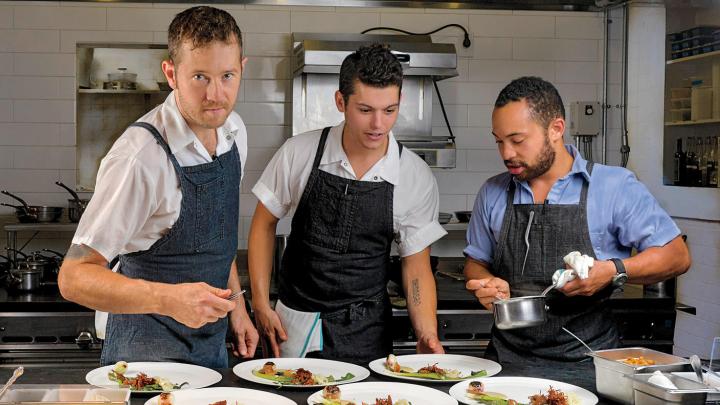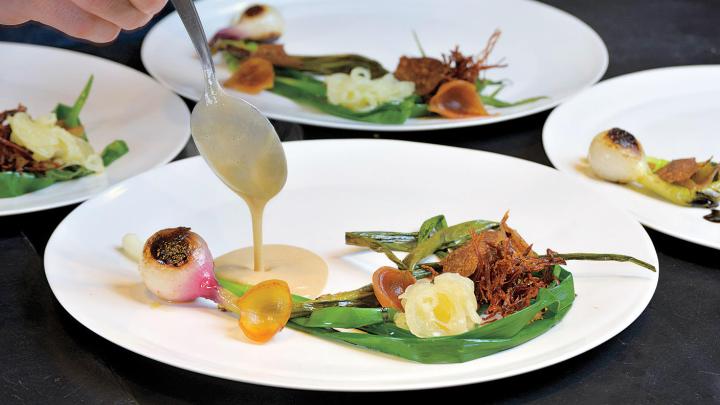A close look at Asta’s sign reveals the name of the storefront’s old occupant, Café 47 Pizza and Pasta. “We realized that we could just spray paint over the rest of the sign and keep the ’asta,’” explains Shish Parsigian, who co-owns and runs the restaurant with her partner, chef Alex Crabb. “Our contractor was horrified.”
Inside, this “design by subtraction” continued. They tore down the black drop ceiling, patching and painting the original tin panels gold, then used the same paint to touch up a picture of Zeus found behind a demolished wall—the logo for an even older incarnation, Despina’s pizzeria. They also left the crooked, raw-plaster edging where the drop ceiling had been, and a swath of exposed bricks. “The contractor said, ‘I’ve got a guy who can get it straight and smooth—it’s going to look primo,’ ” reports Crabb. “And we were like, ‘No, we’re from Detroit. We like it. A lot.’ ”
Before opening Asta in early 2013, the L’Espalier veteran spent two months apprenticing at Copenhagen’s Noma, soaking up its spare Nordic style and almost primal focus on food. At Asta, diners sit at wooden tables with no apparent place settings (tip: open the drawers underneath). Dishes are vaguely titled “turnip,” “beef,” “fiddleheads,” and “onion.” Misgivings can ensue, Parsigian says, with a laugh: “ ‘What’s this crazy restaurant?’ But we are about making and plating this food and not about all the other trappings.”
Make no mistake: Asta is an original. Each night Crabb offers three tasting menus—three-course ($45), five-course ($70), and eight-course ($95), to which wine pairings may be added. One night, a meal began with a shallow bowl of blanched and buttered peas with goat cheese. Not chèvre, this cheese is made in-house and is unrefined, so it has a clean, custardy texture. It comes with shavings of fermented rutabaga and diced preserved lemon; a purple chive blossom adds a hot nip. The turnip dish features the vegetable quartered and roasted, poached, and even raw (in moon-shaped discs), with a salted-plum vinaigrette, rolled-up, pickled green radish leaves, a cèpe foam, flecks of miso shortbread, and a baby nasturtium flower.
The food may appear fussy, but Crabb, who started working in kitchens as a teenager, lacks pretension. There is enough to eat, but diners leave truly sated because Asta’s inventive aesthetic is so stimulating: it forces people to slow down, take small bites, and enjoy the adventure of figuring out what’s what. “We think that’s fun,” says Parsigian, a former manager at Hi-Rise Bread Company in Cambridge. “Then, when they are curious and excited, they call us over to find out what all the elements are.”
And the onion dish is deceptively complicated. Crabb starts with a sweet roasted spring Vidalia for drama, then adds the “green unctuousness” of a poached scallion, with its “slimy chewiness.” Petals of pickled pearl onions are placed on the plate with tweezers, then splashed with balsamic vinegar; another yellow dollop turns out to be “onion that has been cooked down with buttermilk whey and a little champagne vinegar,” he reports. The black drizzles are burnt-onion oil—a bitter contrast to the dish’s last touch: a luxurious spoonful of beer-and-cheddar purée.
Among the onions is a nest of twiggy, crispy beef—because Crabb often treats protein as a condiment. In this case, the fibers of a rib-eye steak cooked with wine are pulled apart, slow-fried, then seasoned. “It’s not a beef dish,” Parsigian tells patrons, “it’s an onion dish.” Almost every dish is just as carefully composed, although Crabb says the inspiration for the onion plate’s “look” came one day when he saw wasted bits of fresh greens lying “in a nice circular pattern” around the sink drain.
When served, the ingredients form a crescent shape along the side of the plate. “And we will get the jokesters who say, ‘Where’s the rest of the food? Why is it all over there?’ ” reports Crabb. For him, it’s obvious: “Because the negative space on the plate helps you focus on what’s there.”
That also explains why he cooks. Growing up in Michigan, he struggled with attention-deficit issues, and still does. But in the extreme chaos of commercial kitchens, Crabb found solace. His seemingly opposite traits—a sharp, kinetic intensity and the ability to shift quickly among diverse tasks—enabled him to thrive. “When I was 16 or 17, I was making omelets at a breakfast place,” he says, “and those two-and-a-half hours of service were the only time my teenage mind was quiet. And it was so nice.”








